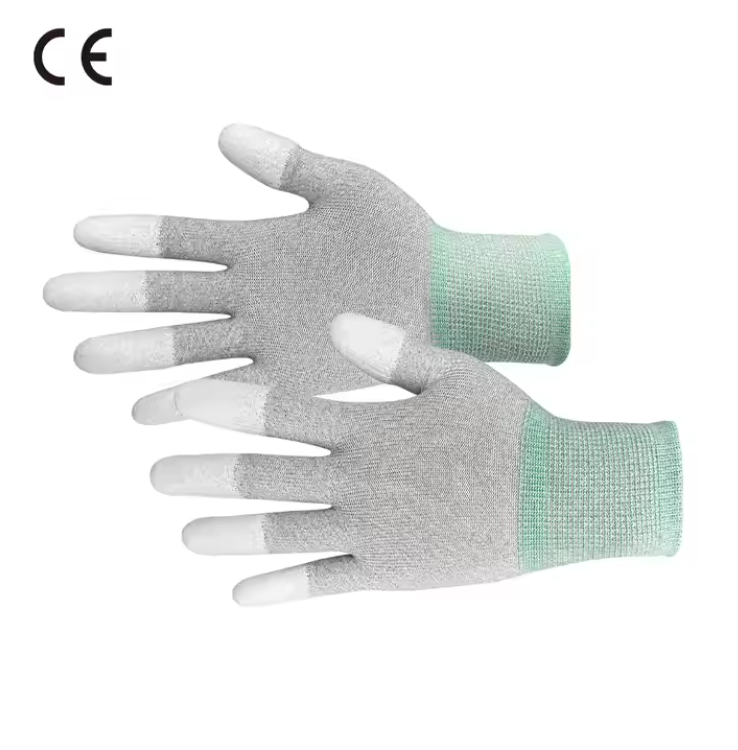
What Are Static Proof (ESD) Gloves?
Static proof gloves are specially designed gloves that protect electronic components, circuit boards, or sensitive materials from electrostatic discharge (ESD) generated by the human body.
They are made with conductive or dissipative fibers to safely channel and dissipate static electricity away from your hands to a grounded surface—without passing static into the product you're handling.
Why Are They Needed?
Electrostatic discharge can:
Damage microchips and semiconductors
Cause latent component failure
Compromise product quality in cleanrooms or labs
Create sparks in flammable or explosive environments
Even tiny amounts of static (as low as 100V) can destroy sensitive electronic components. Since gloves are often worn in cleanrooms or while assembling electronics, ordinary gloves can build up static and are not safe.
How Do Static Proof Gloves Work?
They work by incorporating carbon fiber, conductive yarn, or copper-infused threads into the glove material. This gives the glove a low surface resistivity, allowing static charges from the hands to:
Move into the gloves
Flow through conductive fibers
Discharge into a grounded surface (e.g., ESD mat or wrist strap)
Typical resistance range:
➡️ Between 10⁵ to 10¹¹ ohms (Ω), depending on material and application
Types of ESD-Safe Gloves
➤ By Material:
| Material | Description | Use Case |
|---|---|---|
| Nylon + Carbon Fiber | Soft, breathable, conductive | General electronics handling |
| Polyester + Carbon | Lightweight, durable | Assembly line work |
| Copper-infused Fabric | High conductivity | Advanced cleanroom applications |
| Latex/Nitrile Coated Palm | Anti-slip, abrasion-resistant | Assembly work, small parts |
| PU (Polyurethane) Coated | Excellent grip and dexterity | SMT/SMD assembly, lab work |
By Type:
| Type | Description |
|---|---|
| Full Finger | Covers entire hand, most common |
| Finger Cot | Covers individual fingers only |
| Half Finger | For higher tactile feedback |
| Palm-coated | PU/Nitrile coating on palm/fingers for grip |
| Cleanroom-compatible | Lint-free, non-shedding, ultra-low particulate |
Where Are They Used?
Electronics assembly and repair
Semiconductor and PCB manufacturing
Cleanroom operations (class 1000+)
Medical device manufacturing
Optics, aerospace, telecom
Explosive-handling areas
Key Properties to Look For
| Property | Description |
|---|---|
| Surface resistance | Ideally 10⁵–10⁹ Ω/sq |
| ESD compliance | Meets IEC 61340, ANSI/ESD STM11.11 |
| Lint-free / non-shedding | For cleanroom use |
| Breathability | For comfort in long shifts |
| Tactility | Fine motor control for small components |
| Fit | Snug without tightness for precision and comfort |
How to Choose the Right ESD Gloves ?
Application
Assembly line: PU-coated gloves for grip
Cleanroom: Lint-free, class-rated gloves
Precision work: Thin, high-sensitivity gloves
Size
Gloves should fit snugly—too loose = poor contact, too tight = discomfort
Durability
Reusable gloves for cost-effectiveness
Disposable gloves for hygiene-critical settings
Budget
Basic nylon-carbon gloves: $1–3/pair
High-performance cleanroom gloves: $5–15/pair
Care and Maintenance
Wash gently (warm water, mild soap)
Air dry (no high heat—can degrade conductive fibers)
Replace if:
Surface becomes worn
Resistance test fails
Shedding or contamination begins
Common Mistakes to Avoid
| Mistake | Why It's a Problem |
|---|---|
| Wearing over dry hands/clothes | No proper static path |
| Using non-ESD gloves | Increases ESD risk |
| Not grounding yourself | Gloves help—but personal grounding is still needed! |
| Dirty or worn gloves | Can lose conductivity |
Compliance and Standards
ANSI/ESD STM11.11 – Testing surface resistance of gloves
IEC 61340-5-1 – ESD control program standard
ISO 14644 – Cleanroom compatibility (if applicable)
Recommended Brands
ESD Factorys
